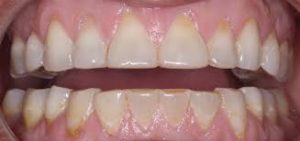
In yoga, many of the poses involve balancing positions. Stances such as Warrior, Tree, and Figure 4 help our bodies focus on its natural balance, its harmony.
If you think about it, our bodies were designed, from our head to our toes, for balance. The head balances on our spinal column, which is a delicately-stacked arrangement of discs that house the spinal column. When one disc moves ever-so-slightly out of its position, the results can be far-reaching.
The same applies to the hip, knees, and ankles. They all require a balanced alignment.
Your jaw joints rely on this same balance. The temporomandibular joints are often referred to as “TMJ.” If you place your fingers on both sides of your face just in front of your ears, you’ll feel these joints move when you open and close your mouth.
These joints move a lot! As a matter of fact, keep your fingers on these joints and swallow and you’ll feel them move even then. Because these joints are designed to work together, you can imagine that all this movement requires proper alignment for proper balance.
An imbalance of these joints often occurs when the teeth are not in their proper positions. The congruency of teeth when biting, chewing or speaking is based – here again – on balance. Proper function requires their ability to move with ease as one, together in harmony.
Like a spinal disc that has moved out of proper alignment, all it takes is one tooth out of position (or missing) to create an imbalance that has far-reaching repercussions.
For example, let’s say your lower, front teeth become crowded and crooked. As they tilt and turn, the upper teeth designed to meet them when speaking and in chewing motions begins to occur with less unity.
As you chew, a lower tooth may occasionally hit an upper tooth in an awkward way. It may be barely noticeable the first time. It may even seem to be a fluke. Yet, it may occur again and again (or even during sleep) to the point that one of the teeth becomes cracked, or chipped, or broken.
Although the jaw joints may seem to be removed from how the upper teeth and lower teeth work together, the TMJ relies tremendously on their unified interaction.
In the same way that the hip joints hinge the thigh bones (femurs) to the torso, your jaw joints hinge the lower jaw to the skull. Since our TMJ are probably the most active joints in the body, any disparity can “rub them the wrong way.”
Stress or strain on these joints can wear them down as well as cause inflammation. As we’ve all learned, inflammation in the body causes the brain to send in the forces meant to calm this process. The brain tells the jaw to seek out a harmonious position so strain is eliminated.
This is where night-time clenching and grinding can come into play. During sleep, our brains are actively ‘helping’ the jaw joints find a comfortable resting position. Hence, it subconsciously seeks out a balanced position for the joints in a back-&-forth grinding or clenching of upper teeth to lower.
This is where worn teeth, chipped or broken teeth can also occur.

Teeth worn down from night-time grinding
Since facial muscles are involved in the process of clenching and grinding, frequent headaches and/or migraines can also occur. As the inflammation extends into the ear chamber, it can cause ear ringing and dizziness. Neck and shoulder muscles can ache as well.
As a neuromuscular dentist, I know it takes very little to trigger this domino effect. I’ve seen a number of patients who were told, for years, that their bite was ‘correct’ and their headaches or facial pain were unrelated to their bite. However, having a patient put their top teeth on top of their bottom and slide them back and forth doesn’t really give a full picture of what’s going on, in many cases.
Using advanced diagnostic equipment and training, we’ve pinpointed a number of bite imbalances and jaw joint disorders that were overlooked or not obvious. For some patients, we’ve been able to rule out that their bite or TMJ was the culprit of certain symptoms. For others, we’ve been able to make adjustments to their bite with minor tooth reshaping or new crown(s).
While some individuals require orthodontic realignment (our team includes an orthodontist, who provides ‘braces’ and Invisalign ‘clear braces’) to bring teeth into proper positions, some cases require a combination of ortho plus crowns.
We consider that every person’s requirements for balance is different, which applies to the structures in the head (jaws, joints, teeth, muscles) just as much as to a spinal column or hip joints.
Let’s discuss your needs during a no-cost private session. Here, in our Shelby Twp dental office, we are always pleased to welcome new patients. During this time, I’ll explain the process that provides clear, concise answers related to your bite alignment.
Call 586-739-2155 to schedule. Or, ask for an information packet to get to know more about our conveniently located Macomb Co. dental office.